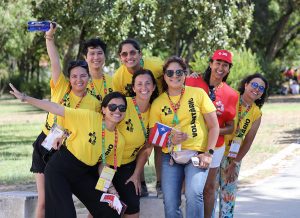(OSV News) – “In the United States, more than 60% of the Hispanic community is under 18 years of age, (so) we have to talk about youth ministry, not because (young people) are the future but because they are the present,” said Félix Palazzi as he began a webinar on “Transforming Futures: Visions and Challenges of Youth Ministry in America.”
Palazzi, a theologian and member of the board of directors of the National Catholic Council for Hispanic Ministry, opened the April 10 Spanish-language webinar featuring a panel of four leaders whose work experiences in various areas of youth and young adult ministry — often referred to as pastoral juvenil — reflect its realities at the diocesan and national levels in the U.S. and at the Latin American and Caribbean levels.

Presenting the work done by the National Catholic Network de Pastoral Juvenil Hispana, known as LaRED, in leadership formation was José Julián Matos Auffant, vice president of this organization that was established in 1997 “with the mission of promoting, supporting, and accompanying the missionary disciples who are the young people,” he said.
With the Década de la Pastoral Juvenil (Decade of Hispanic Youth/Young Adult Ministry) underway — a project that began in 2020 and is scheduled to conclude in 2030 — Matos said his organization intends to “foster communication, collaboration, and mutual support among all agents of youth ministry” in addition to “establishing a bridge between civic and ecclesial organizations that work with Hispanic-Latino youth and young adults and with youth ministry in Latin America.”
Matos said that LaRED’s ambitious plan seeks to organize youth ministry at the diocesan level in each diocese of the United States, setting the course for the development of this ministry, so that it acquires a vital role in parish life during the next six years.
The hard work that LaRED does to involve more Hispanic/Latino youth in the life of the church aligns with the mission of the Pastoral Juvenil Latinoamericana y Caribeña (Latin American and Caribbean Youth Ministry), an organization belonging to the Latin American Episcopal and Caribbean Council, explained Paola Balanza, a 22-year-old from Tarija, Bolivia.
Balanza said this ministry is organized in four regions: the Mexico and Central America Region; the Caribbean Region; the Andean Region, of which she is a delegate; and the Southern Cone Region, made up of Chile, Uruguay, Argentina, Paraguay and Brazil.
Describing the tight bonds among the young people in the organization, Balanza also spoke of the challenges it has faced in recent years, highlighting the COVID-19 pandemic and the political problems facing several nations in Latin America.
Youth and young adult ministries suffered as a result of these events, as many groups disintegrated; others were forced to discontinue their daily meetings and activities. Many young people also lost their lives in the political conflicts, Balanza said, adding: “It has taken us a long time to rebuild, to be able to work from within, because these conflicts have had a significant impact on the young person’s being.”
However, the young Bolivian said that the 2021 Ecclesial Assembly of Latin America and the Caribbean in Mexico, where she participated as a young assembly member, brought with it hope for her organization by recognizing young people as agents of transformation in society. This “has really given us a lot of visibility and also a lot of work, organized with the entire church,” she explained.
Responding to Pope Francis’ call to go out to encounter everyone where they are, especially to be able to reach young people through the use of technology, Andreina Barroso from Lente Católico (Catholic Lens) spoke about her organization’s project for the digital evangelization of young people.
Barroso said it is an “informative and entertaining” Catholic content channel that publishes information for young people of all ages, written by young people and endorsed by priests.
Content is based on the doctrine of the catechism, is of quality and is completely free, added Barroso, giving credit for this effort to “groups of donors, who want to invest in the growth of the faith of our young people.”
For her part, Brilema Pérez, associate director of the Office of Youth and Young Adults of the Diocese of San Diego, spoke of the experience of youth ministry in dioceses and parishes — especially in border contexts, as her diocese is located just across the border from Tijuana, Mexico.
She noted that young immigrants come to these Catholic communities with a vision and their own way of expressing their spirituality, informed by their unique life experiences, “so, in those moments, more than anything, our role at the diocesan level is to support them.”
Speaking about the ever-changing nature of the border environment, Pérez said that while for many years, young people arriving were mostly from Mexico, that is no longer the case.
“We are seeing more diversity in the various countries of Latin America. … Among them are the Mayan communities, El Salvador, Central America, Venezuela,” she said.
This means, Pérez pointed out, that pastoral juvenil needs to constantly reinvent itself to ask “¿Quiénes son los jóvenes?” (“Who are the youth?”), instead of evangelizing with a uniform vision.
